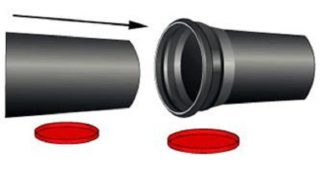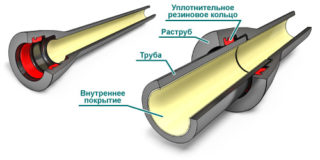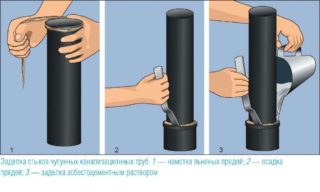Installation of a sewer collector implies a reliable connection of pipe elements. As a result of the work performed, the system should have excellent tightness. To achieve a tight joining of the tubes with each other, the bell of the sewer pipe allows. In order to correctly connect the elements in this way, special skills and knowledge of collector installation methods are required.
Definition and purpose of the socket of the sewer pipe

A flare is a special expansion at one end of a sewer element. The standard end of the next tube is inserted into it. According to the standards, all bell-shaped products have one flat cut and one extended cut. Thus, all the elements are sequentially joined through the socket.
By the type of material of manufacture, there are several types of products for sewage:
- ceramic;
- cast iron;
- polymer;
- concrete.
The methods of sealing the joints depend on the material of the elements used.
The bell performs the following functions:
- allows you to mount the manifold without clamps, fittings and other auxiliary parts;
- ensures the tightness of the system along the entire diameter;
- works as a stiffener in the construction of an underground external collector;
- simplifies assembly / disassembly of system sections.
A sewer collector with sockets serves for 50 or more years without the need for repairs.
Sizes of sockets
The main dimensions of polymer pipes for laying the inside of the sewerage system:
| Pipe section (mm) | Socket inner diameter (mm) | Socket length (mm) |
| 32 | 32,3 | 18 (min) and 24 (max) |
| 40 | 40,3 | 18 (min) and 26 (max) |
| 50 | 50,3 | 18 (min) and 28 (max) |
| 75 | 75,4 | 18 (min) and 33 (max) |
| 110 | 110,4 | 22 (min) and 36 (max) |
Methods for installing pipes using sockets
Installation of PVC or polypropylene system
Two methods are used here - glue / sealant or O-rings. In the first case, the funds are applied to the end of the tube inserted into the socket and driven into the groove to the limit. Preliminarily, the extreme part of the product is lightly treated with coarse emery. The elements collected in the manifold are left until the glue / sealant has completely dried (as a rule, information about the time is indicated on the instructions for the mixture).
O-rings are used if the product is equipped with a special groove for them. The rubberized element must be uniformly elastic without cracks or tears. The sealant is inserted into the groove, then the end of the next tube is treated with a sealant and it is fitted into the bell of the previous one until it stops.
Cast iron collector installation
- At the end of the tube driven into the socket, a mark is made equal to the length of the groove.
- 1-2 cm recede from the notch and wrap the product with tow in an even row.
- The finished piece of the sewer element is driven into the bell until it stops, parallel to sealing the winding with a chisel.
- Pour bituminous mastic or cement solution into the existing gap.
- It remains to wait a day until the solution is completely dry. After that, you can use the collector.
According to the same principle, ceramic and asbestos-cement sewage pipes are mounted.
Welding of cast iron pipes is used extremely rarely, since this installation method requires special equipment. Work is performed in the following sequence:
- The end of the flat tube is driven into the socket until it stops and the gap is filled with a cement mixture. It is important to leave at least 1 cm from the end of the funnel.
- After the solution has dried, a special composition for resistance welding is placed in the remaining space and welded to the base of the drive-in element.
After the welds have cooled down, you must immediately check the manifold for leaks.
Dismantling the socket element
Carrying out repair work of the sewer system is often associated with the need to dismantle its section. Here they act depending on the method of the previously carried out joining of tubes:
- When using sealant or glue, it is enough to forcefully pull the driven pipe towards you. It leaves the groove easily enough.
- If capping was used, it is necessary to cut a piece of the product down to the funnel. Then the remaining segment of the tube is marked with a perforator into four elements and each of them is taken out using a chisel and a hammer.
When using resistance welding, proceed in the same way.










